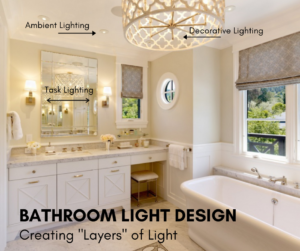 Prior to working at Best at Finding Solutions my knowledge of bathroom lighting was limited. Honestly, I assumed that installing appropriate bathroom lighting focused on two things: 1.) finding a light fixture that was aesthetically pleasing, and 2.) ensuring said light fixture produced enough light for the room. However, I was quick to learn that there was far more to the lighting process than originally thought.
Prior to working at Best at Finding Solutions my knowledge of bathroom lighting was limited. Honestly, I assumed that installing appropriate bathroom lighting focused on two things: 1.) finding a light fixture that was aesthetically pleasing, and 2.) ensuring said light fixture produced enough light for the room. However, I was quick to learn that there was far more to the lighting process than originally thought.
The bathroom is a tricky space because it needs to balance function and style. In terms of function, aside from doing your “business”, our bathrooms provide space for us to prepare for our day. Whether its shaving, doing your hair, or putting on make-up, proper lighting assists us in performing these everyday tasks. In addition to completing such tasks, the bathroom also needs light distributed throughout the room, and if we are able, it is nice to include lighting to make the room aesthetically pleasing as well. So if we put these three items together we are talking about creating what is known as “layers of light”. In the bathroom this means we are balancing function and style with task, ambient, and accent/decorative lighting.
TASK LIGHTING. As mentioned above, in the bathroom we need proper lighting to perform everyday tasks, such as shaving, putting on make-up, etc. What I’ve come to understand is that sconces, whether they are attached directly to the mirror or on either side, is one of the best ways to ensure sufficient task lighting. Sconces will create cross-illumination when placed at either side of the mirror at eye-level. This placement will ensure that you avoid creating shadows over your vanity (and possibly your face).
Not every bathroom is made to have sconces on either side of the mirror. For example, if your mirror is very wide, it would not be appropriate to place sconces on either side of the mirror. There wouldn’t be enough light created to fully illuminate the space. As a result, strategically placed sconces over the mirror may be a better solution.
AMBIENT LIGHTING. Ambient lighting will reflect off of the ceiling and bathroom surfaces to fill the room with general light. Recessed fixtures or pendants are a great way to create this effect. However, while this will illuminate the room, it does not provide sufficient light for all tasks.
ACCENT/DECORATIVE LIGHTING. This is the fun stuff (and totally extra). Accent lighting can be used to draw attention to art work, plants, or other items in your bathroom. Decorative lighting adds drama to the space. A great example of this would be placing a chandelier over the tub.
If you look around your own bathroom, particularly a master bath, you may notice a combination of at least two of these types of lighting, most likely ambient and task. However, if you are looking to add a little something “extra” to your bathroom, a new accent or decorative light fixture may be the way to go. Whether it is a blinged out chandelier or your tub or an interesting pendant in a powder room (which doesn’t need optimal lighting for tasks), a new light fixture can create interest and aesthetics in a space so it can be both functional and beautiful.
